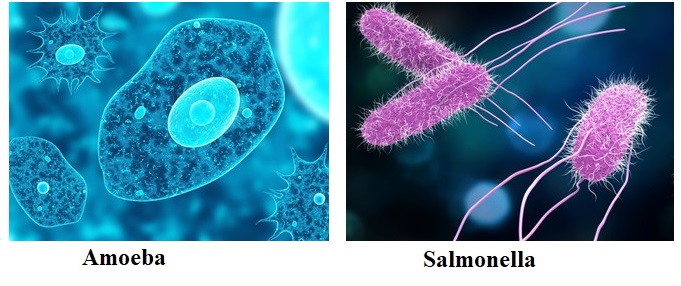Protozoa and bacteria are both unicellular organisms that survive independently.

They have many similarities like in food habits, reproduction, habitat, parasitic behavior, and the ability to cause diseases.
However, there are few major differences between them, as per the needs of the nature.
20 Differences between Protozoa vs Bacteria
| Sr No. | Difference | Protozoa | Bacteria |
|---|---|---|---|
| 1 | Size / dimension | Protozoa are larger than bacteria with an average size of 50μm. | Bacteria are comparatively bacteria are smaller and around 0.5–5.0μm. |
| 2 | Shapes | Irregular, slipper, oval, round-shaped. | Spherical, filament, chain, corkscrew. |
| 3 | Cell type | Eukaryotic cell with a distinct nucleus. | A prokaryotic cell without a nucleus. |
| 4 | Cell wall | Lacks cell wall around the plasma membrane | Has a thick cell wall as a protective cover around the plasma membrane |
| 5 | Cell flexibility | The cell is flexible. | Cell is rigid and shape does not change. |
| 6 | Mitochondria | Mitochondria present | Absent. |
| 7 | Spore Stage | Spore formation is absent | Forms spore to tide over harsh conditions. |
| 8 | Toxins | Protozoa do not produce toxins. | Bacteria produce both endo and exotoxins to destroy other cells. |
| 9 | Movement | All protozoans are movable. Pseudopodia, Cilia, or flagella are responsible for their movements. | Many bacteria are motile but some are non-motile. Motile bacteria can do so due to flagella. |
| 10 | Climate requirements | They are present in all habitats but are not tolerant of harsh conditions. | They require normal conditions but can live in extreme cold, heat, and Acidic and alkaline pH. |
| 11 | Respiration | Only Aerobic forms are present. | Most bacteria are Aerobic, but few anaerobic ones exist (Ex: clostridium). |
| 12 | Food habits | Protozoans rely on organic matter, while some, like euglena, opt for photosynthesis. | Bacteria are either autotrophs, heterotrophs, chemotrophs, saprophytes, commensals, or parasites. |
| 13 | Reproduction | Protozoans reproduce asexually by binary fission and sexually by conjugation | Bacteria reproduce asexually by binary fission. But sexually |
| 14 | Scientific Applications | Protozoa comparatively are less useful for scientific and technological benefits. | Bacteria find wide usage and are explored for rDNA, biotechnology, and medical uses. |
| 15 | Drug effects | They are easily killed by drugs and have less resistance. | Bacteria like tuberculosis and Pseudomonas are less affected by drugs. In general, bacteria can develop resistance to most antibiotics. |
| 16 | Stress resistant | Resistant | Highly resistant (can tolerate heat, cold, drought, and other adverse conditions). |
| 17 | Taxonomical position | As per taxonomy, they are eukaryotes and hence are in higher order than bacteria. | They are prokaryotes and are assigned the lowest position in the taxonomy chart. |
| 18 | Predation | Protozoa eat bacteria | Bacteria try to resist protozoa predation. |
| 19 | Disease Examples | Amebiasis, Malaria. | Syphilis, Tuberculosis. |
| 20 | Examples | Amoeba, Paramecium, Euglena | Salmonella, Pseudomonas, E-Coli. |
The above points on bacteria vs. protozoa indicate the specific properties of bacteria, which make them more robust and omnipresent.
Mitochondria produce energy in the form of ATO through oxidative phosphorylation, while in bacteria, the inner cell membrane produces ATP as it has protein complexes.
The protons are pumped into the space between the cell membrane and cell wall, where they are used by ATP synthase to produce ATP.
Spore formation
Bacteria transform into spores when conditions are unfavorable and emerge from the spore when conditions are favorable.
Therefore, spores are protective stages of bacteria and are difficult to destroy.
Climate requirements
Bacteria can survive in severely cold and hot conditions, unlike protozoa. For example, the bacterium Thermus aquaticus can grow at a temperature of 70-75℃.
In contrast, Planococcus halocryophilus bacteria live at temperatures of -15℃.
Food habits
From the above, it appears that their food habits are similar, like being either autotrophs or heterotrophs. But, some bacteria are also chemotrophs, meaning they derive energy by oxidation of inorganic materials like iron, sulfur, or magnesium.
Their reproduction is also similar as they both have binary fission for asexual reproduction and conjugation for sexual reproduction. But bacteria show more options like transduction and transformations.
For human use, bacteria are used for biotechnology, fermentation, and in the food industry. But, protozoa find less use comparatively.
As prokaryotic cells, the DNA and RNA synthesis also varies slightly in bacteria, making them an easy target for antibiotics.
Frequently Asked Questions and Answers
What is one way to determine if a cell is a protozoan or a bacteria?
One can differentiate a protozon cell from bacteria by simple Gram staining technique. Bacteria would give gram stain colors while protozoan mostly don’t.
Besides a culture of protozoan cells can grow in presence of penicillin but not the bacteria.